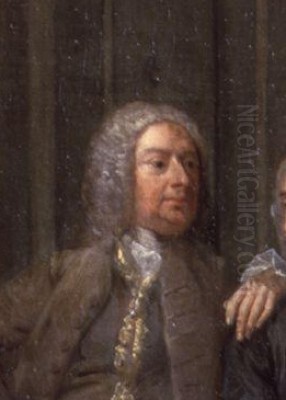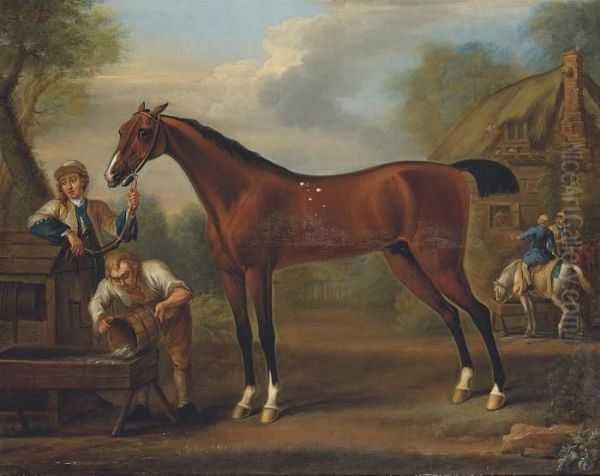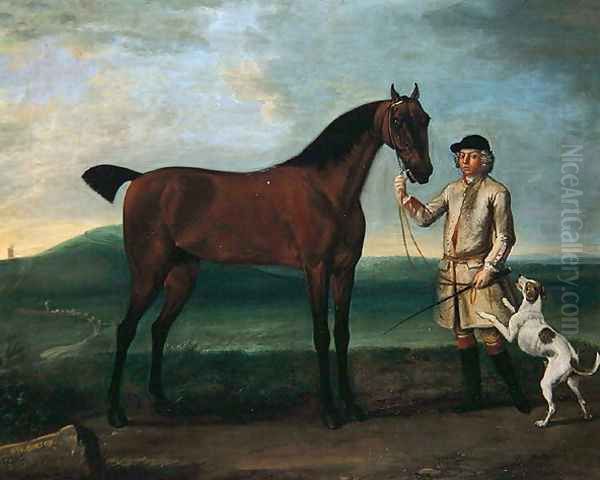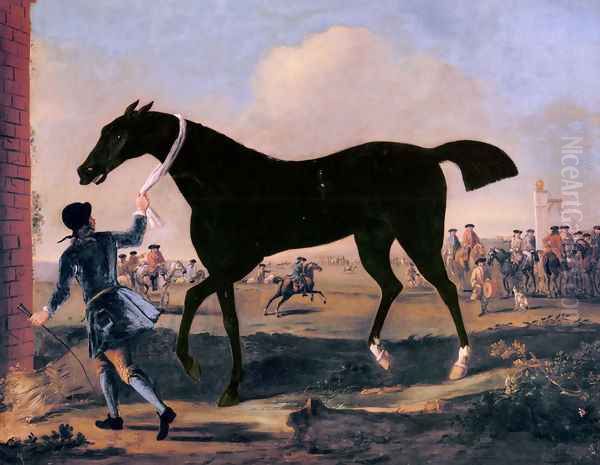
John Wootton stands as a seminal figure in the history of British art, particularly celebrated for his foundational role in establishing sporting painting and landscape as significant genres in the early eighteenth century. Born around 1682 in Snitterfield, Warwickshire, and living until 1764, Wootton's career spanned a crucial period of cultural development in Britain. He navigated the transition from foreign artistic dominance towards a distinctly native school of painting, leaving an indelible mark through his depictions of equestrian subjects, hunt scenes, and classically inspired landscapes. His work not only captured the passions of the landed gentry but also contributed significantly to the visual identity of the British countryside in art.
Early Life and Artistic Formation
Details of John Wootton's earliest years remain somewhat obscure, a common fate for artists of his time before the advent of extensive record-keeping. However, tradition holds that his birthplace was Snitterfield, near Stratford-upon-Avon. His artistic inclinations appear to have been recognized and nurtured early on, potentially through connections to aristocratic households known for their patronage of the arts. The Beaufort family, prominent landowners with estates like Badminton House, are often cited as early supporters. It's suggested that Lady Anne Somerset, daughter of the first Duke of Beaufort, played a role in encouraging the young Wootton.
Crucially, these connections may have led him to the tutelage of Jan Wyck (c. 1645–1702), a Dutch painter who had settled in England and specialized in battle scenes and equestrian subjects. Wyck's influence is discernible in Wootton's early work, particularly in the dynamic composition of horses and figures. Learning from a respected immigrant artist like Wyck provided Wootton with a solid technical grounding in the established Continental traditions, which was essential for any aspiring painter in London at the turn of the eighteenth century. This training equipped him with the skills necessary to capture the likeness and movement of horses, a prerequisite for success in the burgeoning field of sporting art.

After his initial training, Wootton established himself in London, the epicentre of artistic patronage and opportunity in Britain. The city offered access to wealthy clients, fellow artists, and the developing infrastructure of the art world, such as artists' clubs and early exhibition venues. His move to the capital marked the beginning of a long and prosperous career catering to the tastes of the British elite.
The Rise of Sporting Art in Britain
The late seventeenth and early eighteenth centuries witnessed a surge in the popularity of field sports among the British aristocracy and landed gentry. Horse racing, fox hunting, and shooting were not merely pastimes but integral parts of social life, status display, and the rural economy. This cultural phenomenon created a demand for art that celebrated these activities, immortalizing prized animals, recording famous races, and depicting the rituals of the hunt. John Wootton emerged as one of the very first and most accomplished British artists to meet this demand systematically.
Before Wootton, depictions of such scenes were often undertaken by visiting Dutch or Flemish artists, like the aforementioned Jan Wyck or Abraham Hondius. Wootton, alongside contemporaries like Peter Tillemans and James Seymour, helped to naturalize the genre, developing a distinctly British approach. He specialized in painting portraits of specific, famous racehorses, often commissioned by their proud owners. These were not generic representations but detailed likenesses, celebrating the speed, beauty, and lineage of thoroughbreds that were becoming increasingly important.
His hunting scenes captured the energy and social dynamics of the chase, featuring packs of hounds, riders in colourful attire, and the backdrop of the British countryside. These large-scale canvases often adorned the halls of country houses, serving as visual records of the owners' sporting prowess and connection to the land. Wootton's ability to combine accurate animal portraiture with lively narrative and evocative settings made him exceptionally popular with patrons eager to see their passions reflected in high art.
Mastery of Equine Portraiture
Central to Wootton's success was his exceptional skill in depicting horses. In an era obsessed with horse breeding and racing – Newmarket was already establishing itself as the headquarters of the sport – the ability to capture the form, spirit, and individual characteristics of a horse was highly valued. Wootton excelled in this, producing numerous 'portraits' of celebrated stallions and racehorses, often shown with their jockeys, grooms, or owners.

His equine portraits, such as the depiction of the legendary undefeated racehorse Flying Childers, or the influential sire Bay Bolton, demonstrate a keen observation of equine anatomy and conformation. While perhaps lacking the almost scientific precision that George Stubbs would later achieve through dissection, Wootton's horses possess a vitality and presence that appealed greatly to his clients. He understood how to convey the sleek lines, muscular power, and noble bearing of the thoroughbred. His early work, like the 1711 portrait of Bonny Black, already shows a sophisticated understanding of the subject.
Wootton often depicted these horses in profile or slightly angled poses, emphasizing their elegant silhouettes against landscape backgrounds. He paid close attention to details like glossy coats, alert expressions, and fine tack. These were not just animal paintings; they were status symbols, celebrating the investment and prestige associated with owning champion bloodstock. His ability to satisfy this specific niche secured him commissions from the highest levels of society, including royalty and powerful dukes.
Hunting Scenes and Country Life
Beyond individual horse portraits, Wootton was a master of the complex hunting scene. These compositions typically involved multiple figures, numerous hounds, and expansive landscape settings. He captured the various stages of the hunt, from the gathering of the riders to the full cry of the chase and the final moments of capturing the quarry. These paintings offered a dynamic spectacle, filled with movement, colour, and the distinctive atmosphere of rural sport.
Works depicting hunts, such as those commissioned for Althorp or Longleat House, often function as group portraits, including recognizable likenesses of the patron, their family members, guests, and principal servants like the huntsman. The hounds, too, were often painted with attention to individual characteristics, reflecting the importance of breeding and maintaining a quality pack. Wootton skillfully arranged these complex elements into coherent and engaging narratives, balancing the action of the hunt with the details of the surrounding environment.
His travels to various country estates across England allowed him to incorporate specific topographical features into his paintings, grounding the idealized sporting activities in recognizable locations. He painted views of estates like Badminton, Newmarket Heath, and the grounds surrounding houses such as Petworth House. These works provide valuable visual records of eighteenth-century country life, landscape management, and the social rituals that bound the landed classes together. A work like Tom Johnson's Hound at the Archway exemplifies his focus on the key elements of the hunt, including the prized animals.
Development as a Landscape Painter

While renowned for his sporting subjects, John Wootton was also a significant landscape painter in his own right, and indeed, the landscape often formed an essential component of his sporting pictures. His landscape style evolved throughout his career. Initially influenced by Dutch and Flemish traditions, characterized by a certain realism and attention to detail, his work gradually absorbed the influence of classical landscape painting, particularly the works of French artists active in Rome: Claude Lorrain and Gaspard Dughet (also known as Gaspard Poussin, Nicolas Poussin's brother-in-law).
This shift likely occurred following a period spent in Rome around 1720, although details of this trip are debated by historians. Exposure to the Italian Campagna and the works of Claude and Dughet introduced Wootton to a more idealized and structured approach to landscape. Claude Lorrain's influence can be seen in Wootton's handling of light, often suffused and atmospheric, creating a sense of serene grandeur. Gaspard Dughet's impact is evident in the compositional structures, often featuring framing trees, rolling hills, and classical ruins or buildings, creating a sense of timeless stability and order.
Wootton successfully integrated these classical elements into British settings, creating landscapes that were both idealized and recognizably English. He became adept at composing large, panoramic views, often incorporating topographical accuracy with classical compositional devices. This fusion helped lay the groundwork for the great tradition of British landscape painting that would flourish later in the century with artists like Richard Wilson and Thomas Gainsborough. His landscapes provided noble settings for his sporting scenes but also stood alone as accomplished works celebrating the beauty, real or imagined, of the British countryside.
Classical and Continental Influences
The assimilation of classical landscape principles marked a significant step in Wootton's development and in the broader evolution of British art. The Grand Tour was becoming increasingly fashionable for young aristocrats, fostering an appreciation for classical antiquity and Italianate landscapes. Wootton tapped into this burgeoning taste, offering patrons landscapes that evoked the Arcadian ideals associated with Claude Lorrain and Gaspard Dughet, but often set within their own estates.
His adoption of Claudian light, with its warm, golden tones, and Dughet-esque compositions, featuring carefully arranged trees, distant vistas, and sometimes classical architecture, elevated his work beyond mere topographical record or sporting illustration. It imbued his scenes with a sense of dignity and timelessness that resonated with the aspirations of his patrons, who often saw themselves as inheritors of classical virtues and custodians of an ordered, productive landscape.
This classical influence distinguished Wootton's work from the more purely topographical or Dutch-influenced styles prevalent earlier. He demonstrated that British scenery could be treated with the same artistic seriousness previously reserved for Italian landscapes. While artists like Jan Siberechts had earlier painted British estates, Wootton's synthesis of observation and classical idealism represented a new direction. This approach paved the way for later artists like Richard Wilson, often called the 'father of British landscape painting', who would more fully develop a classically inspired yet distinctly British landscape vision.
Major Works and Commissions
Throughout his long career, John Wootton produced a substantial body of work, much of which was commissioned for specific locations within the grand houses of his patrons. These large-scale decorative schemes often included sets of sporting scenes, landscapes, and battle pieces. Notable examples include the series of hunting and racing scenes painted for the 3rd Duke of Beaufort at Badminton House, works for the Duke of Devonshire, the Duke of Rutland at Belvoir Castle, and extensive commissions for Edward Harley, 2nd Earl of Oxford, at Wimpole Hall.
His paintings for Longleat House in Wiltshire and Althorp House in Northamptonshire are particularly famous, depicting lively hunting scenes set within the recognizable parklands of these estates. These works often feature portraits of the family and their prized horses and hounds. The Warren Hill at Newmarket is one of his most iconic compositions, capturing the bustling atmosphere of the famous training grounds with numerous horses, trainers, and spectators. It exemplifies his ability to handle complex multi-figure compositions within an expansive landscape.
Other significant works include portraits of specific horses like Flying Childers, Bay Bolton, and Grey Cary (often depicted with Petworth House in the background). His landscapes, such as views of classical ruins or idealized pastoral scenes, demonstrate his versatility. While many works remain in the houses for which they were painted (often now in the care of organisations like the National Trust), others have entered public collections, allowing wider appreciation of his skill and historical importance. Titles like Red Dragon with Chichester Harbour and beyond suggest his range included coastal scenes as well, blending topography with his characteristic style.
Wootton and his Contemporaries
John Wootton operated within a vibrant London art world. His primary contemporaries and sometimes rivals in the field of sporting art were Peter Tillemans (c. 1684–1734) and James Seymour (1702–1752). While Tillemans had a broader range, including topographical views and conversation pieces, and Seymour focused almost exclusively on racing subjects with a somewhat more naive charm, Wootton was arguably the most versatile and classically grounded of the three, achieving the greatest social and financial success.
He was also part of a wider artistic and cultural milieu. He was associated with the informal gatherings of artists and intellectuals at Slaughter's Coffee House and was a member of the St Luke's Club of Artists. His patrons connected him to leading figures in other fields. For instance, his work for patrons like the Earl of Oxford or Frederick, Prince of Wales, placed him in circles that included prominent writers like Alexander Pope and John Gay, and architects and designers like William Kent. Kent, in particular, shared an interest in integrating art and landscape, designing gardens and interiors where Wootton's paintings would often hang.
Wootton's relationship with the next generation is also significant. He is known to have taught the landscape painter George Lambert (1700–1765), who became a founding member of the Royal Academy. More broadly, Wootton's success and style set a benchmark. While George Stubbs (1724–1806) would later revolutionize equine art with his anatomical studies, Wootton established the genre's viability and popularity, creating the market that Stubbs and others would inherit. His landscapes also contributed to the climate in which Richard Wilson (1714–1782) and Thomas Gainsborough (1727–1788) could develop their own distinctive approaches to British scenery, moving beyond mere topography towards more expressive interpretations. He existed alongside major figures like William Hogarth (1697-1764), Sir James Thornhill (c. 1675-1734), and Jonathan Richardson (1667-1745), each contributing to the burgeoning confidence of the British school.
Patronage and Success
John Wootton enjoyed remarkable success throughout his career, attracting patronage from the highest echelons of British society. His client list reads like a 'who's who' of the Georgian aristocracy. He worked extensively for the first three Dukes of Beaufort, the Dukes of Devonshire, Rutland, Richmond, and Leeds, the Earls of Oxford, Egremont, and Coventry, and Sir Robert Walpole, Britain's first Prime Minister. Perhaps his most prestigious patron was Frederick, Prince of Wales, for whom he painted numerous works for Leicester House. He also received commissions from King George II.
This elite patronage ensured a steady stream of lucrative commissions, allowing Wootton to live comfortably and maintain a studio in Cavendish Square, a fashionable part of London. His ability to satisfy the specific tastes of these powerful individuals – celebrating their sporting pursuits, their prized animals, and their landed estates – was key to his sustained success. His paintings became essential components of the decoration and status display in countless country houses.
His membership in artists' societies like the St Luke's Club indicates his standing within the profession. While the formal Royal Academy of Arts was founded shortly after his death, Wootton belonged to the preceding generation that professionalized art practice in Britain and raised the status of native-born artists. His financial success and the widespread demand for his work demonstrated that British artists could compete effectively with foreign imports, particularly in genres that resonated strongly with British cultural identity, like sporting art and landscape.
Later Life and Legacy
John Wootton remained active as a painter well into his later years, continuing to receive important commissions. He died in London in 1764, having maintained his position as the leading sporting artist of his generation for several decades. He was buried in the Oxford Chapel (now St Peter's, Vere Street). His death marked the end of an era, just as new talents like George Stubbs were beginning to reshape equine painting and the landscape school was gaining momentum.
Wootton's legacy is significant and multifaceted. He was a crucial pioneer in establishing sporting art as a respected genre in Britain, moving it beyond simple illustration towards sophisticated artistic compositions. His detailed and lively depictions of horses set a standard for equine portraiture that influenced subsequent artists. His integration of sporting subjects with landscape backgrounds helped to elevate both genres.
In landscape painting, he played a vital role as a transitional figure, absorbing Continental influences, particularly the classical idealism of Claude Lorrain and Gaspard Dughet, and adapting them to British scenery. This synthesis helped pave the way for the great flowering of British landscape painting in the later eighteenth and nineteenth centuries. Artists like George Lambert directly benefited from his teaching, while the general appreciation for landscape he fostered created fertile ground for Gainsborough and Wilson. Even Stubbs, while revolutionary in his anatomical approach, built upon the tradition of aristocratic patronage and subject matter that Wootton had largely established.
Collections and Recognition
Today, John Wootton's works are held in numerous important public and private collections, testifying to his historical significance and enduring appeal. The Royal Collection Trust holds a significant number of his paintings, reflecting his royal patronage. Tate Britain possesses several key works, offering a public showcase of his contribution to British art. Many of his large-scale commissions remain in the country houses for which they were painted, accessible through institutions like the National Trust, particularly at properties such as Petworth House, Althorp, and Longleat.
Other major UK institutions holding his work include the Fitzwilliam Museum in Cambridge, the Ashmolean Museum in Oxford, Manchester Art Gallery, and the Yale Center for British Art in New Haven, Connecticut, which has a strong collection of British sporting art. His paintings frequently appear at auction, demonstrating continued market interest. Scholarly attention has also grown, with exhibitions and publications exploring his role in the development of British art, acknowledging him not just as a 'sporting painter' but as a versatile artist who made significant contributions to landscape and even battle painting. His work provides invaluable insights into the culture, pastimes, and aesthetic tastes of Georgian Britain.
Conclusion: A Foundational Figure
John Wootton occupies a pivotal position in the narrative of British art. Emerging at a time when native artistic traditions were still finding their voice, he carved out a highly successful career by specializing in subjects close to the heart of his patrons – the horse, the hunt, and the country estate. He elevated sporting art from a minor craft to a major genre, combining accurate observation with dynamic composition. Simultaneously, he was instrumental in introducing and adapting the classical landscape tradition to British shores, influencing the course of landscape painting for generations to come.
His ability to synthesize Dutch realism, French classicism, and British subject matter resulted in a unique and influential style. While later artists like Stubbs would achieve greater anatomical accuracy, and painters like Gainsborough and Turner would reach new heights of landscape expression, Wootton laid essential groundwork. He demonstrated that British artists could excel in genres previously dominated by foreigners, and he created enduring images that capture the spirit of the British aristocracy and their connection to the land in the vibrant Georgian era. His legacy resides not only in his numerous canvases but also in his role as a foundational figure for distinctly British schools of painting.